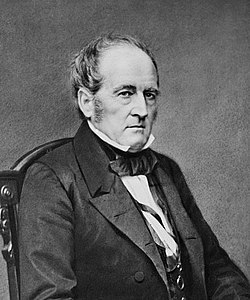Top Qs
Timeline
Chat
Perspective
1836–37 United States House of Representatives elections
House elections for the 25th U.S. Congress From Wikipedia, the free encyclopedia
Remove ads
The 1836–37 United States House of Representatives elections were held on various dates in various states between July 4, 1836, and November 7, 1837. Each state set its own date for its elections to the House of Representatives, either before or after the first session of the 25th United States Congress convened on September 4, 1837. With Arkansas and Michigan officially achieving statehood in 1836 and 1837, respectively, the size of the House was set at 242 seats.
Remove ads
Though Democrat Martin Van Buren was elected president in November 1836, Democrats lost seats. The newly organizing Whigs benefited from regional candidacies and issues and voter fatigue with outgoing two-term President Andrew Jackson. Jackson, a flamboyant public personality with a record of high-profile leadership and historic military success, often clashed with Congress and the Supreme Court. By comparison, Van Buren, a brilliant partisan organizer and political operative, was less charismatic in looks and demeanor. Voter support for the minor Anti-Masonic and Nullifier parties ebbed, but remained significant. One Independent, John Pope, was elected from Kentucky.[1][2][3]
Remove ads
Election summaries
| 128 | 7 | 1 | 6 | 100 |
| Democratic | AM | I | N | Whig |
Remove ads
Special elections
Summarize
Perspective
There were special elections in 1836 and 1837 to the 24th United States Congress and 25th United States Congress.
Special elections are sorted by date then district.
24th Congress
Note: In some sources, parties are listed as "Democrats" and "Whigs." However, they are listed here as "Jacksonian" and "Anti-Jacksonian" (respectively) to conform to the party names as they were regarded during the 24th United States Congress.
25th Congress
Remove ads
Alabama
This section needs expansion. You can help by adding to it. (February 2020) |
Arkansas
24th Congress
The new state of Arkansas was admitted to the Union on June 15, 1836, and elected its sole at-large member August 1, 1836. He was seated December 5, 1836,[5] to finish the term that would end the following March.
25th Congress
Arkansas elected its member October 2, 1837, this time for a full term.
Remove ads
Connecticut
Summarize
Perspective
Connecticut went from six at-large seats to six districts for the first time. Elections were held April 3, 1837, after the new term began but before the Congress convened. All incumbents from the at-large district were re-elected in districts.
Remove ads
Delaware
This section needs expansion. You can help by adding to it. (February 2020) |
Florida Territory
See Non-voting delegates, below.
Georgia
This section needs expansion. You can help by adding to it. (February 2020) |
Illinois
Summarize
Perspective
Illinois elected its three members on August 1, 1834.
Indiana
This section needs expansion. You can help by adding to it. (February 2020) |
Kentucky
This section needs expansion. You can help by adding to it. (February 2020) |
Remove ads
Louisiana
This section needs expansion. You can help by adding to it. (February 2020) |
Maine
Maine elected its members September 12, 1836, except one district went to multiple ballots later in the year.
This section needs expansion. You can help by adding to it. (February 2020) |
Maryland
This section needs expansion. You can help by adding to it. (February 2020) |
Massachusetts
Summarize
Perspective
Elections were held November 14, 1836.
Michigan
Michigan elected its sole member late on August 22, 1837.
Mississippi
Summarize
Perspective
A special election was held in Mississippi on July 17–18, 1837. Its winners were Democrats John F. H. Claiborne and Samuel J. Gholson. The first session of the 25th Congress was a special session beginning on September 4, 1837, extending to October 16. In November, Mississippi, held the regular election. Seargent Smith Prentiss, a Vicksburg lawyer and Whig, unexpectedly launched a vigorous, partisan campaign. He and fellow Whig Thomas J. Word won in an upset. Claiborne and Gholson then argued that the July result entitled them to serve full terms. With the Whig Party newly organizing, the closely divided House, in which Anti-Masons, Nullifiers, and the Independent tended to align more with Whigs and to oppose Democrats, agreed to hear Prentiss. He spoke for nine hours over three days, packing the gallery, drawing Senators, and earning a national reputation for oratory and public admiration from leading Whigs including Senators Clay and Webster. The Elections Committee then required a third election. Scheduled for April 1838, it confirmed the November result. Both Whigs were seated in May late in the second session, also serving for the third session.
Missouri
This section needs expansion. You can help by adding to it. (February 2020) |
New Hampshire
This section needs expansion. You can help by adding to it. (February 2020) |
New Jersey
New York
This section needs expansion. You can help by adding to it. (February 2020) |
North Carolina
This section needs expansion. You can help by adding to it. (February 2020) |
Ohio
This section needs expansion. You can help by adding to it. (February 2020) |
Pennsylvania
Rhode Island
This section needs expansion. You can help by adding to it. (February 2020) |
South Carolina
This section needs expansion. You can help by adding to it. (February 2020) |
Tennessee
Summarize
Perspective
Elections held late, on August 3, 1837
Vermont
Virginia
Wisconsin Territory
See Non-voting delegates, below.
Non-voting delegates
See also
Notes
- John Pope won as an Independent and would run later as a Whig.
- Does not include state results listed above due to special election and Independent Representative.[4]
- The decision was later rescinded, leading to a new special election.
References
Bibliography
External links
Wikiwand - on
Seamless Wikipedia browsing. On steroids.
Remove ads

